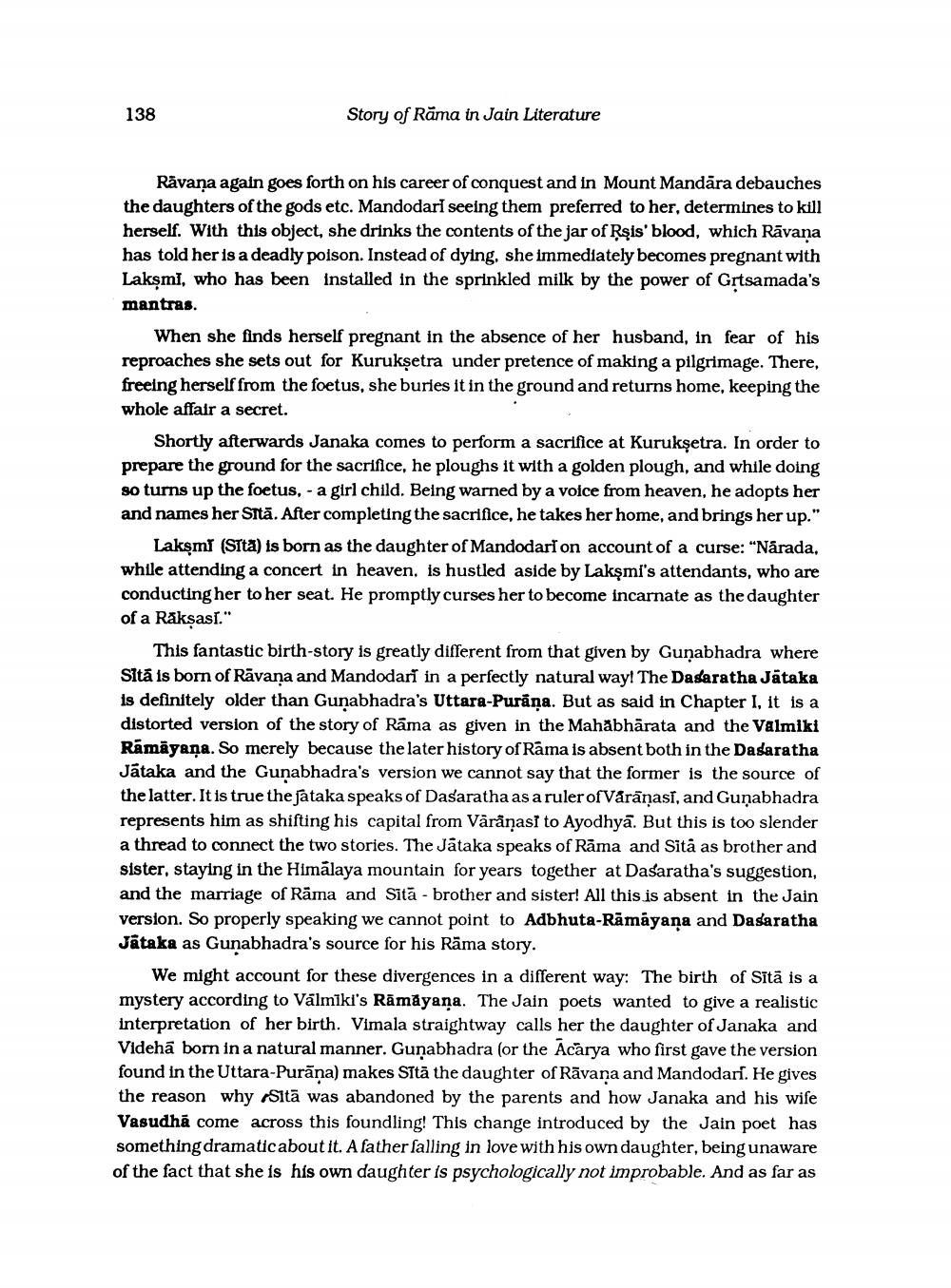________________
138
Story of Rāma in Jain Literature
Rāvana again goes forth on his career of conquest and in Mount Mandāra debauches the daughters of the gods etc. Mandodari seeing them preferred to her, determines to kill herself. With this object, she drinks the contents of the jar of Rşis' blood, which Rāvana has told her is a deadly poison. Instead of dying, she immediately becomes pregnant with Lakşmi, who has been installed in the sprinkled milk by the power of Grtsamada's mantras.
When she finds herself pregnant in the absence of her husband, in fear of his reproaches she sets out for Kuruksetra under pretence of making a pilgrimage. There, freeing herself from the foetus, she burles it in the ground and returns home, keeping the whole affair a secret.
Shortly afterwards Janaka comes to perform a sacrifice at Kurukşetra. In order to prepare the ground for the sacrifice, he ploughs it with a golden plough, and while doing so turns up the foetus, - a girl child. Being warned by a voice from heaven, he adopts her and names her Sitā. After completing the sacrifice, he takes her home, and brings her up."
Lakşmi (Sta) is born as the daughter of Mandodars on account of a curse: "Nárada, while attending a concert in heaven, is hustled aside by Lakşmi's attendants, who are conducting her to her seat. He promptly curses her to become incarnate as the daughter of a Raksasi."
This fantastic birth-story is greatly different from that given by Guņabhadra where Sitā is born of Rāvana and Mandodarí in a perfectly natural way! The Dasaratha Jätaka is definitely older than Gunabhadra's Uttara-Purāņa. But as said in Chapter I, it is a distorted version of the story of Rāma as given in the Mahabharata and the Valmiki Rāmāyana. So merely because the later history of Rama is absent both in the Dasaratha Jataka and the Gunabhadra's version we cannot say that the former is the source of the latter. It is true the jataka speaks of Dasaratha as a ruler of Varanasi, and Guņabhadra represents him as shifting his capital from Vārānasi to Ayodhyā. But this is too slender a thread to connect the two stories. The Jätaka speaks of Rāma and Sità as brother and sister, staying in the Himalaya mountain for years together at Dasaratha's suggestion, and the marriage of Rāma and Sitā - brother and sister! All this is absent in the Jain version. So properly speaking we cannot point to Adbhuta-Rāmāyaṇa and Dasaratha Jätaka as Gunabhadra's source for his Rāma story.
We might account for these divergences in a different way: The birth of Sītā is a mystery according to Vālmīki's Rāmāyana. The Jain poets wanted to give a realistic interpretation of her birth. Vimala straightway calls her the daughter of Janaka and Videhā born in a natural manner. Gunabhadra (or the Acarya who first gave the version found in the Uttara-Purāņa) makes Sitā the daughter of Rāvana and Mandodars. He gives the reason why «Sitā was abandoned by the parents and how Janaka and his wife Vasudhā come across this foundling! This change introduced by the Jain poet has something dramatic about it. A father falling in love with his own daughter, being unaware of the fact that she is his own daughter is psychologically not improbable. And as far as




